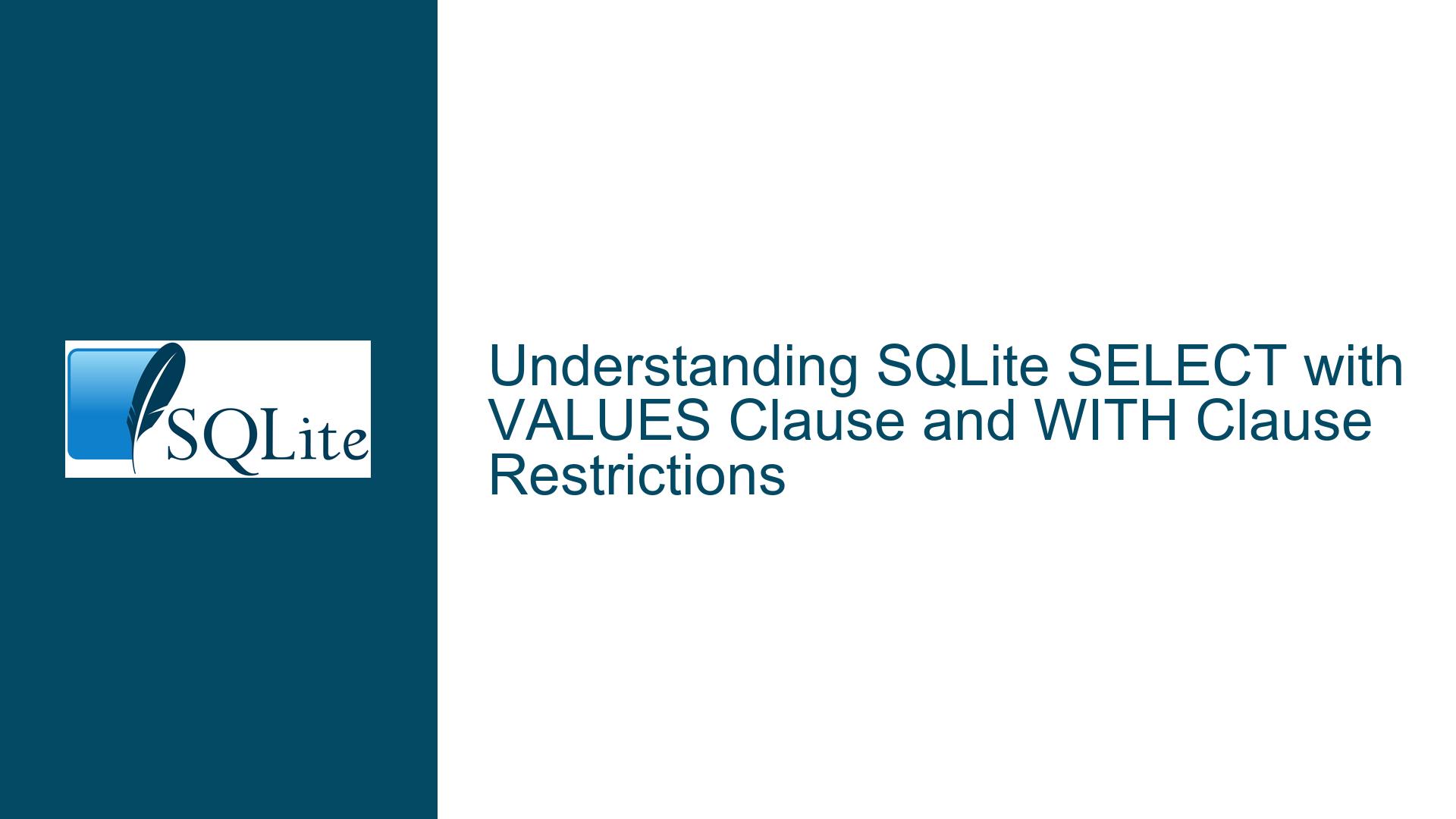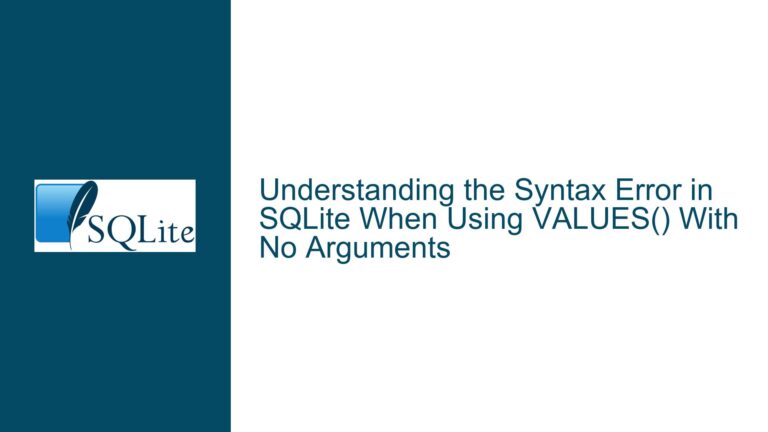SQLite SELECT with VALUES Clause and WITH Clause Restrictions
SQLite SELECT Statement Syntax Ambiguity with VALUES and WITH Clauses
The SQLite documentation explicitly mentions that while a VALUES clause can be the first element in a compound SELECT statement that uses a WITH clause, a simple SELECT statement consisting solely of a VALUES clause cannot be preceded by a WITH clause. This restriction has led to confusion among developers, as the syntax appears to be valid and executable in some SQLite versions, yet it is flagged as non-compliant with the documented behavior. The core issue revolves around understanding why this restriction exists, whether it is a syntax error, or if the combination of WITH and VALUES clauses is semantically invalid despite being syntactically permissible.
The confusion arises because the SQLite parser allows the execution of a WITH clause followed by a VALUES clause in certain versions, even though the documentation states that this combination is not allowed. This discrepancy between documentation and implementation raises questions about the intended behavior of SQLite and whether the documentation needs to be updated or if the implementation contains a bug. To fully understand this issue, we must delve into the specifics of SQLite’s syntax parsing, the role of the WITH clause, and the limitations of the VALUES clause in different contexts.
Interplay Between WITH Clause and VALUES Clause in SQLite Syntax Parsing
The WITH clause in SQLite is used to define Common Table Expressions (CTEs), which are temporary result sets that can be referenced within a SELECT, INSERT, UPDATE, or DELETE statement. CTEs are particularly useful for breaking down complex queries into simpler, more manageable parts. On the other hand, the VALUES clause is a shorthand for generating a table-like structure with a set of rows and columns, often used in INSERT statements or as a standalone query.
The restriction mentioned in the documentation likely stems from the fact that a VALUES clause is not a full-fledged SELECT statement but rather a simplified form of one. When a WITH clause is used, it is typically intended to provide a temporary result set that can be referenced in a subsequent SELECT statement. However, a VALUES clause does not provide the same level of flexibility or functionality as a SELECT statement, making the combination of WITH and VALUES clauses semantically ambiguous or redundant.
The SQLite parser’s ability to execute a WITH clause followed by a VALUES clause in some versions suggests that the parser may not enforce the documented restriction strictly. This could be due to the parser’s leniency in handling certain edge cases or an oversight in the implementation. However, the fact that the documentation explicitly prohibits this combination indicates that it is not a supported or intended use case, even if it happens to work in some scenarios.
Resolving the Ambiguity: Syntax Validation and Query Restructuring
To address the ambiguity between the documented behavior and the actual implementation, developers should adhere to the documented restrictions and avoid using a WITH clause followed by a VALUES clause in simple SELECT statements. If the goal is to use a CTE with a VALUES clause, the query should be restructured to comply with the documented behavior. One approach is to use a compound SELECT statement where the VALUES clause is the first element, as this is explicitly allowed.
For example, instead of writing:
WITH t(c) AS (SELECT 5) VALUES((SELECT * FROM t), 2, 3);
The query can be rewritten as:
WITH t(c) AS (SELECT 5) SELECT * FROM (VALUES((SELECT * FROM t), 2, 3));
This restructuring ensures that the WITH clause is used in conjunction with a full SELECT statement, aligning with the documented behavior and avoiding potential issues with syntax validation.
Additionally, developers should be aware of the specific version of SQLite they are using, as the behavior of the parser may vary between versions. If the parser in a particular version allows the combination of WITH and VALUES clauses, it should not be relied upon, as this behavior may change in future updates. Instead, developers should follow best practices and adhere to the documented syntax rules to ensure compatibility and maintainability of their SQLite queries.
In cases where the combination of WITH and VALUES clauses is necessary, developers should consider alternative approaches, such as using a temporary table or a subquery, to achieve the desired result. For example, instead of using a WITH clause, a temporary table can be created and populated with the required data, which can then be referenced in a VALUES clause. This approach provides greater flexibility and avoids the ambiguity associated with the combination of WITH and VALUES clauses.
By understanding the nuances of SQLite’s syntax parsing and adhering to the documented restrictions, developers can avoid potential pitfalls and ensure that their queries are both syntactically correct and semantically meaningful. The key takeaway is to prioritize clarity and compliance with the documented behavior, even if the parser allows for certain deviations. This approach not only enhances the reliability of the queries but also ensures that they remain compatible with future versions of SQLite.
In summary, the restriction on using a WITH clause followed by a VALUES clause in simple SELECT statements is rooted in the semantic limitations of the VALUES clause and the intended use of CTEs in SQLite. While the parser may allow this combination in some versions, it is not a supported or intended use case, and developers should adhere to the documented behavior to avoid potential issues. By restructuring queries and following best practices, developers can achieve the desired results while maintaining compatibility and clarity in their SQLite queries.






